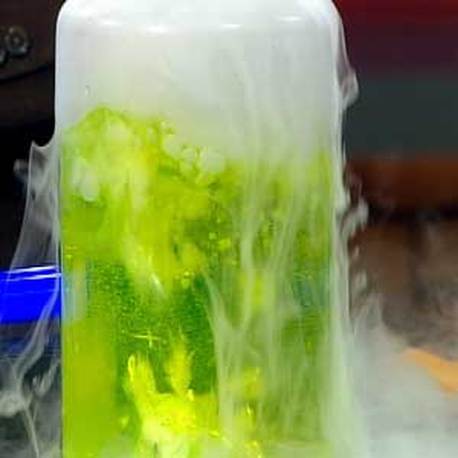Chemical Properties of Dry Ice
Acidity: Dry ice is an acidic oxide. It has a slightly acidic nature and therefore will turn blue litmus paper red. It forms carbonic acid when it reacts with water, and carbonates or bicarbonates when it reacts with bases or basic oxides (such as sodium hydroxide or sodium oxide).
Combustibility: Dry ice does not support combustion and it is not flammable. This characteristic, combined with the inert nature of dry ice is used in fire extinguishers.
Reactivity: Dry ice undergoes chemical reactions with different substances. For example, dry ice reacts with magnesium. When added to burning magnesium, dry ice will glow white. When you open the shell of magnesium, after the fire goes out, you will find a black powder which is the carbon from the dry ice. The combustion of magnesium ignites the oxygen of dry ice, leaving only carbon behind. This change in chemical composition makes this a chemical characteristic.
Dissolvability: You can dissolve dry ice into other liquids to create solutions that change the chemical composition of dry ice. For example, you can mix the dry ice with water. The atoms of carbon dioxide are uniformly mixed and bond with atoms of water creating the composite H2CO3, known as carbonic acid.
Special Phases of Matter: Amorphous carbonia can form when an experimenter super-cools hot, gaseous carbon dioxide at extreme pressures. A substance similar to glass, carbonia has physical properties similar to carbon family elements in the periodic table, such as silica. It degrades rapidly at normal atmospheric pressure and returns to gaseous form.
Dry ice also has a critical point (the conditions at which a phase boundary ceases to exist), which is made up of three different properties:
i) Critical Temperature: 87.8 F
ii) Critical Pressure: 1069.4 PSIA (pounds per square inch absolute)
iii) Critical Density: 28.9519 lb./ft.cu.
Dry ice has three different latent heats:
i) Latent Heat of Fusion: 69.9 F
ii) Latent Heat of Vaporization: 0 F
iii) Latent Heat of Sublimation: -110 F
Since dry ice is a solid form of carbon dioxide it has the enthalpy of formation of -393.5 kJ/mol and tends to bond covalently and in covalent network crystals (seen in more detail under structure and bonding).
The process of sublimation that dry ice undergoes is endothermic while the condensation of water is exothermic so the "fog" that comes off of dry ice is room temperature while the actual block of dry ice is cold enough to cause severe frostbite.
Combustibility: Dry ice does not support combustion and it is not flammable. This characteristic, combined with the inert nature of dry ice is used in fire extinguishers.
Reactivity: Dry ice undergoes chemical reactions with different substances. For example, dry ice reacts with magnesium. When added to burning magnesium, dry ice will glow white. When you open the shell of magnesium, after the fire goes out, you will find a black powder which is the carbon from the dry ice. The combustion of magnesium ignites the oxygen of dry ice, leaving only carbon behind. This change in chemical composition makes this a chemical characteristic.
Dissolvability: You can dissolve dry ice into other liquids to create solutions that change the chemical composition of dry ice. For example, you can mix the dry ice with water. The atoms of carbon dioxide are uniformly mixed and bond with atoms of water creating the composite H2CO3, known as carbonic acid.
Special Phases of Matter: Amorphous carbonia can form when an experimenter super-cools hot, gaseous carbon dioxide at extreme pressures. A substance similar to glass, carbonia has physical properties similar to carbon family elements in the periodic table, such as silica. It degrades rapidly at normal atmospheric pressure and returns to gaseous form.
Dry ice also has a critical point (the conditions at which a phase boundary ceases to exist), which is made up of three different properties:
i) Critical Temperature: 87.8 F
ii) Critical Pressure: 1069.4 PSIA (pounds per square inch absolute)
iii) Critical Density: 28.9519 lb./ft.cu.
Dry ice has three different latent heats:
i) Latent Heat of Fusion: 69.9 F
ii) Latent Heat of Vaporization: 0 F
iii) Latent Heat of Sublimation: -110 F
Since dry ice is a solid form of carbon dioxide it has the enthalpy of formation of -393.5 kJ/mol and tends to bond covalently and in covalent network crystals (seen in more detail under structure and bonding).
The process of sublimation that dry ice undergoes is endothermic while the condensation of water is exothermic so the "fog" that comes off of dry ice is room temperature while the actual block of dry ice is cold enough to cause severe frostbite.

